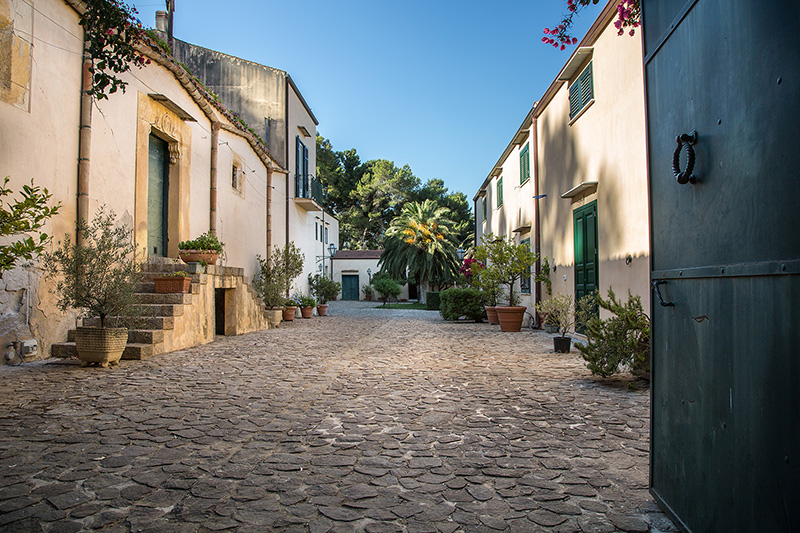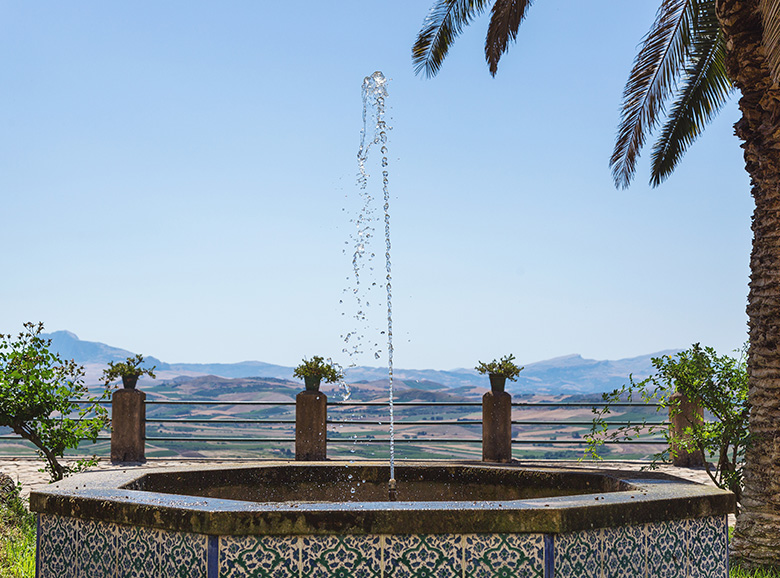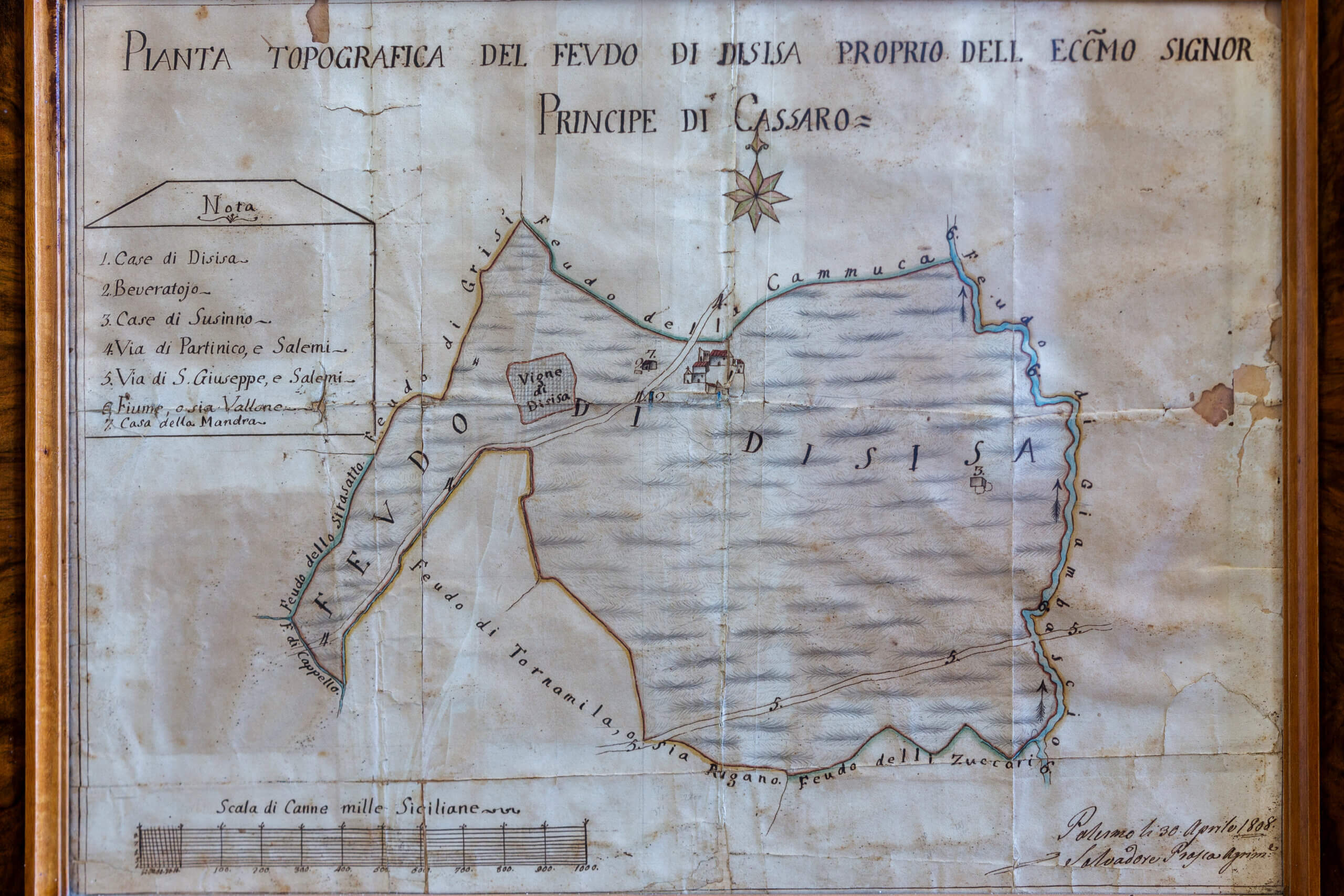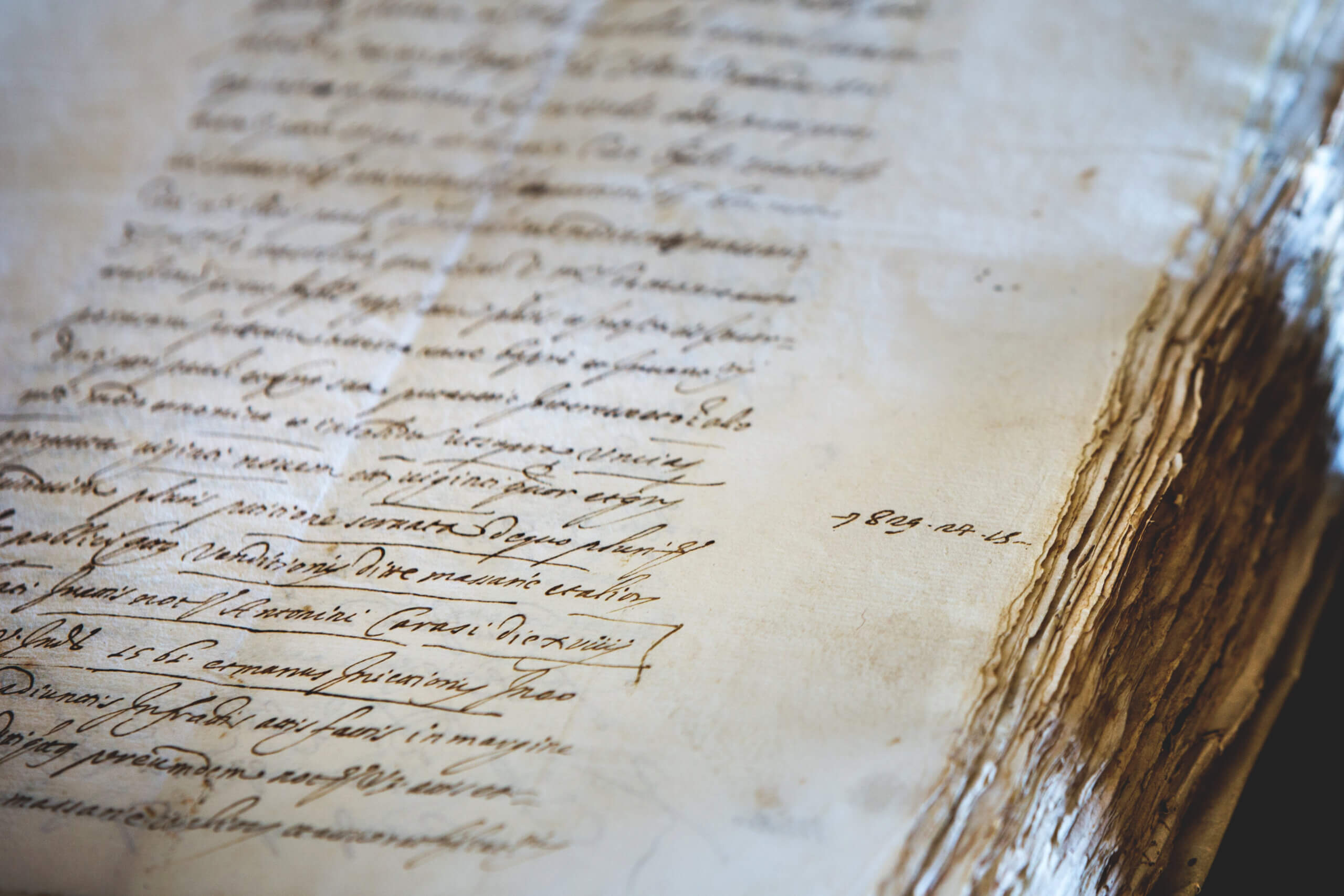THE ESTATE AND ITS HISTORY
Feudo Disisa: a history that looks to the future
A history spanning over eight centuries that saw the peoples of the Mediterranean and northern Europe – Carthaginians, Romans, Arabs and Normans – meet, clash, seek to conquer each other, exchange cultures and traditions that could captivate the imagination of a great novelist.

The origins of Feudo Disisa have their roots in one legendary domination: that of the Normans. We are in the twelfth century, under the rule of the King of Sicily William II, known as Willian the Good, son of William I of Hauteville and Margaret of Navarre. William II ascended the throne at the very young age of twelve and his reign ushered in a new season of peace and reconciliation with the many Sicilian cities hostile to Norman rule. Feudo Disisa was a gift bestowed by King William to the Archbishop of Monreale, the proceeds of which were meant to fund the construction of the city’s cathedral. It was a generous gift, of great agronomic value, and the very name of the estate is a direct testimony of the extraordinary beauty of the place. Disisa derives from the Arabic word "Aziz", which means "the splendid": a term that was already used in 1200 by the emirs who came from the desert to describe the city of Palermo and the beauty of its surrounding countryside, the Conca d'Oro, with its rich farmland fragrant with the aroma of Mediterranean herbs, adorned with palm trees and fountains scattered in the valleys around the Sicilian capital.
An ancient bilingual document - transcribed in Arabic and Latin - testifies that the Disisa estate has belonged to the Diocese of Monreale since 1182. The Archbishopric then bestowed perpetual rights over the land to a family of the Palermo aristocracy, establishing strict management rules and authorizing the cultivation of the vine, which was expressly forbidden to other farming estates in the area. With the abolition of feudal privileges, which put an end to the exercise of temporal power by the ecclesiastical authority, in 1867 the Disisa estate was purchased by the archpriest Nicolò Di Lorenzo.


Since then, the history of the estate has been entwined with that of the Di Lorenzo family who, right from the start, recognized the authentic agricultural vocation of this unique terroir and perfected the most advanced technologies to transform these fertile pastures into lush vineyards and to extract top quality olive oil from the fruits of the ancient "Saracen" olive groves grown on the estate. A history that continues today, thanks to the initiative and craftsmanship of Mario Di Lorenzo, who has forged a new path for Feudo Disisa, with the awareness that today’s wine lovers demand labels able to express the unique organoleptic qualities of their native environment and terroir.
Feudo Disisa: a history that looks to the future
A history spanning over eight centuries that saw the peoples of the Mediterranean and northern Europe – Carthaginians, Romans, Arabs and Normans – meet, clash, seek to conquer each other, exchange cultures and traditions that could captivate the imagination of a great novelist.

The origins of Feudo Disisa have their roots in one legendary domination: that of the Normans. We are in the twelfth century, under the rule of the King of Sicily William II, known as Willian the Good, son of William I of Hauteville and Margaret of Navarre. William II ascended the throne at the very young age of twelve and his reign ushered in a new season of peace and reconciliation with the many Sicilian cities hostile to Norman rule. Feudo Disisa was a gift bestowed by King William to the Archbishop of Monreale, the proceeds of which were meant to fund the construction of the city’s cathedral. It was a generous gift, of great agronomic value, and the very name of the estate is a direct testimony of the extraordinary beauty of the place. Disisa derives from the Arabic word "Aziz", which means "the splendid": a term that was already used in 1200 by the emirs who came from the desert to describe the city of Palermo and the beauty of its surrounding countryside, the Conca d'Oro, with its rich farmland fragrant with the aroma of Mediterranean herbs, adorned with palm trees and fountains scattered in the valleys around the Sicilian capital.

An ancient bilingual document - transcribed in Arabic and Latin - testifies that the Disisa estate has belonged to the Diocese of Monreale since 1182. The Archbishopric then bestowed perpetual rights over the land to a family of the Palermo aristocracy, establishing strict management rules and authorizing the cultivation of the vine, which was expressly forbidden to other farming estates in the area. With the abolition of feudal privileges, which put an end to the exercise of temporal power by the ecclesiastical authority, in 1867 the Disisa estate was purchased by the archpriest Nicolò Di Lorenzo.

Since then, the history of the estate has been entwined with that of the Di Lorenzo family who, right from the start, recognized the authentic agricultural vocation of this unique terroir and perfected the most advanced technologies to transform these fertile pastures into lush vineyards and to extract top quality olive oil from the fruits of the ancient "Saracen" olive groves grown on the estate. A history that continues today, thanks to the initiative and craftsmanship of Mario Di Lorenzo, who has forged a new path for Feudo Disisa, with the awareness that today’s wine lovers demand labels able to express the unique organoleptic qualities of their native environment and terroir.

LU BANCU DI DISISA, BETWEEN TRUTH AND MYTH
The bountiful fertility of these fields, known since ancient times, could not but fuel the popular imagination, giving rise to local legends regarding the existence of a treasure known as "Lu Bancu di Disisa". Scholars of ancient Sicilian lore such as Salvatore Salomone Marino and Giuseppe Pitrè, both mention this legend in their numerous studies.
Lu Bancu di Disisa è un tisoru chi si trova ‘nta li grutti di lufeu di Disisa. Cuntanu l’antichi ca c’è un gran massenti di dinari di munita d’oru e d’argentu, e cu’ è chi li pigghia ‘un trova cchiù la porta nèsciri. Ora certuni vulennu pruvari si putevanu nèsciri, s’hannu pigghiatu ‘na munita d’oru e ‘un hannu pututu nèsciri. E s’hannu pigghiatu in capricciu di fari agghiuttiri òn cani ‘na munita di chisti dintra ‘na muddica di pani, e stu cani ‘un ha pututu nèsciri. E tannu ha nisciutustu cani quannu ha jatu di corpu, ed ha jutupuru la munita. Pi sbancari stu gran Bancu di Disisa vonnu diri l’antichi ca cci voli tri Santi Turrisi di tri capi di regnu, di pò pigghiari ‘na jumenta bianca, ammazzalla e livàricci lu campanàru. Chistu si l’hannu a manciari a frittedda ddàrintra, di pò s’ammazzanu a li tri Santi Turrisi, e lubancu si sbanca.
Banco di Disisa is the name of a fabled treasure supposedly hidden in a cave on the Disisa estate. Legend has it that the treasure consisted of vast amounts of gold and silver coins but that anyone who was lucky enough to unearth it would no longer be able to find his way out of the cave. There are many versions to this story. Some treasure-hunters have tried to take away just one single gold coin and still could not find a way to exit the cave, another one gave a coin to his dog to swallow but, once again, the dog could not get out until it expelled the coin. According to another legend, the treasure of the Banco di Disisa can be conquered only by three people, they must all be named Santi Puglisi and they must come from the three corners of the Sicilian kingdom. The three must enter the cave having killed a white mare. There, they must eat the mare’s entrails cooked according to a special recipe. Only once the three men come out of the cave, and are in turn killed, will the spell of the cave be broken.


LU BANCU DI DISISA, BETWEEN TRUTH AND MYTH
The bountiful fertility of these fields, known since ancient times, could not but fuel the popular imagination, giving rise to local legends regarding the existence of a treasure known as "Lu Bancu di Disisa". Scholars of ancient Sicilian lore such as Salvatore Salomone Marino and Giuseppe Pitrè, both mention this legend in their numerous studies.
Lu Bancu di Disisa è un tisoru chi si trova ‘nta li grutti di lufeu di Disisa. Cuntanu l’antichi ca c’è un gran massenti di dinari di munita d’oru e d’argentu, e cu’ è chi li pigghia ‘un trova cchiù la porta nèsciri. Ora certuni vulennu pruvari si putevanu nèsciri, s’hannu pigghiatu ‘na munita d’oru e ‘un hannu pututu nèsciri. E s’hannu pigghiatu in capricciu di fari agghiuttiri òn cani ‘na munita di chisti dintra ‘na muddica di pani, e stu cani ‘un ha pututu nèsciri. E tannu ha nisciutustu cani quannu ha jatu di corpu, ed ha jutupuru la munita. Pi sbancari stu gran Bancu di Disisa vonnu diri l’antichi ca cci voli tri Santi Turrisi di tri capi di regnu, di pò pigghiari ‘na jumenta bianca, ammazzalla e livàricci lu campanàru. Chistu si l’hannu a manciari a frittedda ddàrintra, di pò s’ammazzanu a li tri Santi Turrisi, e lubancu si sbanca.
Banco di Disisa is the name of a fabled treasure supposedly hidden in a cave on the Disisa estate. Legend has it that the treasure consisted of vast amounts of gold and silver coins but that anyone who was lucky enough to unearth it would no longer be able to find his way out of the cave. There are many versions to this story. Some treasure-hunters have tried to take away just one single gold coin and still could not find a way to exit the cave, another one gave a coin to his dog to swallow but, once again, the dog could not get out until it expelled the coin. According to another legend, the treasure of the Banco di Disisa can be conquered only by three people, they must all be named Santi Puglisi and they must come from the three corners of the Sicilian kingdom. The three must enter the cave having killed a white mare. There, they must eat the mare’s entrails cooked according to a special recipe. Only once the three men come out of the cave, and are in turn killed, will the spell of the cave be broken.


